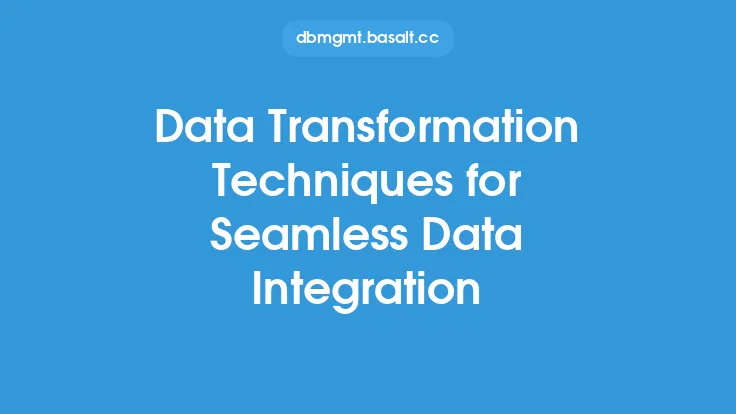Data cleansing is a crucial step in the data normalization process, and handling missing or duplicate data is a significant aspect of it. Missing data can occur due to various reasons such as user error, data entry mistakes, or data import issues, while duplicate data can arise from multiple sources, including data integration, data migration, or user input. In this article, we will delve into the techniques used to handle missing or duplicate data, providing a comprehensive overview of the methods and strategies employed in data cleansing.
Introduction to Handling Missing Data
Handling missing data is a complex task that requires careful consideration of the data's context, quality, and intended use. There are several techniques used to handle missing data, including deletion, imputation, and interpolation. Deletion involves removing the rows or columns containing missing data, which can be effective if the missing data is minimal and not critical to the analysis. However, this method can lead to biased results if the missing data is not randomly distributed. Imputation involves replacing missing data with estimated values, which can be based on statistical models, machine learning algorithms, or domain expertise. Interpolation involves estimating missing values based on the patterns and trends in the existing data.
Techniques for Handling Duplicate Data
Duplicate data can be handled using various techniques, including deduplication, data merging, and data consolidation. Deduplication involves removing duplicate records, which can be done using algorithms that identify and eliminate duplicate rows based on specific criteria. Data merging involves combining duplicate records into a single record, which can be useful when dealing with data from multiple sources. Data consolidation involves aggregating duplicate data into a single record, which can be useful when dealing with data that has multiple versions or updates.
Data Profiling and Data Quality Metrics
Data profiling and data quality metrics play a crucial role in identifying and handling missing or duplicate data. Data profiling involves analyzing the data's distribution, patterns, and relationships to identify potential issues. Data quality metrics, such as data completeness, data accuracy, and data consistency, provide a quantitative measure of the data's quality and help identify areas that require attention. By using data profiling and data quality metrics, data analysts can identify missing or duplicate data and develop targeted strategies to handle these issues.
Statistical Methods for Handling Missing Data
Statistical methods, such as mean, median, and mode imputation, can be used to handle missing data. Mean imputation involves replacing missing values with the mean of the existing values, while median imputation involves replacing missing values with the median of the existing values. Mode imputation involves replacing missing values with the most frequently occurring value. These methods can be effective for handling missing data, but they can also introduce bias and affect the accuracy of the results. More advanced statistical methods, such as regression imputation and multiple imputation, can provide more accurate estimates of missing values.
Machine Learning Algorithms for Handling Missing Data
Machine learning algorithms, such as decision trees, random forests, and neural networks, can be used to handle missing data. These algorithms can learn patterns and relationships in the data and estimate missing values based on the learned patterns. Machine learning algorithms can be more accurate than statistical methods, but they require large amounts of data and can be computationally intensive. Additionally, machine learning algorithms can be sensitive to the choice of hyperparameters and require careful tuning to achieve optimal results.
Data Transformation and Data Normalization
Data transformation and data normalization are critical steps in handling missing or duplicate data. Data transformation involves converting data from one format to another, which can help identify and handle missing or duplicate data. Data normalization involves scaling and transforming data to a common range, which can help improve the accuracy and reliability of the results. By applying data transformation and data normalization techniques, data analysts can reduce the impact of missing or duplicate data and improve the overall quality of the data.
Handling Missing or Duplicate Data in Big Data
Handling missing or duplicate data in big data environments requires specialized techniques and tools. Big data environments often involve large amounts of data from multiple sources, which can make it challenging to identify and handle missing or duplicate data. Distributed computing frameworks, such as Hadoop and Spark, can be used to process large amounts of data in parallel, while data processing tools, such as Apache Beam and Apache Flink, can be used to handle missing or duplicate data in real-time. Additionally, big data analytics platforms, such as Apache Hive and Apache Impala, can be used to analyze and visualize large amounts of data, which can help identify and handle missing or duplicate data.
Best Practices for Handling Missing or Duplicate Data
Best practices for handling missing or duplicate data involve a combination of technical, procedural, and organizational strategies. Technical strategies involve using data profiling, data quality metrics, and statistical and machine learning methods to identify and handle missing or duplicate data. Procedural strategies involve establishing data governance policies, data quality standards, and data processing procedures to prevent missing or duplicate data. Organizational strategies involve providing training and resources to data analysts and stakeholders to ensure that they understand the importance of handling missing or duplicate data and have the skills and knowledge to do so effectively.
Conclusion
Handling missing or duplicate data is a critical aspect of data cleansing, and it requires a combination of technical, procedural, and organizational strategies. By using data profiling, data quality metrics, statistical and machine learning methods, and data transformation and normalization techniques, data analysts can identify and handle missing or duplicate data effectively. Additionally, by establishing data governance policies, data quality standards, and data processing procedures, organizations can prevent missing or duplicate data and ensure that their data is accurate, reliable, and consistent. By following best practices and using specialized tools and techniques, organizations can improve the quality of their data and make better decisions based on accurate and reliable information.





